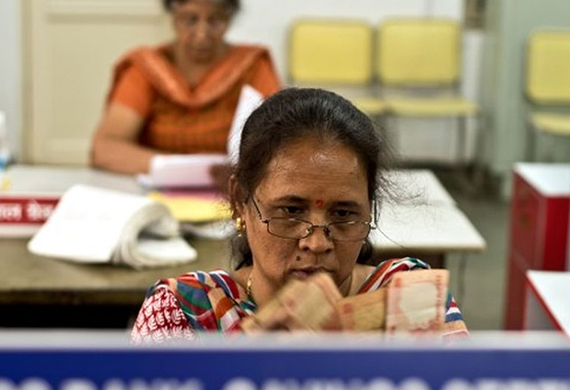
Government Supports hiring more Female Banking Correspondents
By: WE Staff | Thursday, 27 October 2022
To encourage more women to participate in the nation's financial system, the government wants to increase the proportion of female business correspondents (BCs) to one-third of the total by 2027.
Women are thought to be better at managing household finances, so having more women in BC positions should help them plan their finances more effectively, participate in savings programmes and other financial products, and eventually become financially independent, according to two people with knowledge of the discussions.
They claimed that over the course of the next three years, the department of financial services is developing a strategy to increase the proportion of BCs from under 10% to over 30%. A road map for this strategy would be included in the 2019 Union budget's action plan for public sector banks.
Customers in far-flung locations can access banking and financial services at their doorstep thanks to a BC, which is a bank branch's extended arm. There were 1.32 million BCs as of FY22, up from 730,000 in FY20 and 1.13 million in FY21. Less than 10% of these are women, though. For BCs tasked with servicing Pradhan Mantri Jan Dhan Yojana (PMJDY) accounts, the gender imbalance is much more pronounced.
“Women are key to deepening the goals of financial inclusion besides providing financial service providers additional revenue potential to the tune of $700 billion globally. The programme to raise the number of BCs is designed to plug the gap and bring more women into the country’s financial system," said a government official privy to the development.
Questions about increasing female BC numbers were not answered by the finance ministry or the department of financial services (DFS) as of the time of publication.
According to the individuals described above, the DFS established a committee in the latter part of last year, which agreed the recommendation to increase the proportion of women BCs to above 30% by 2027. The largest lender in the nation, State Bank of India, has also approved the initiative that will primarily direct women BCs on servicing women with Jan Dhan accounts.
Government estimates place the number of PMJDY account holders at 463 million as of 10 August. Of them, 55.6% (257 million) are women, and 66.8% (309 million) reside in rural and semi-urban areas, necessitating BC service.
“Even though 56% of bank account holders are women, just about 8-10% of women BCs are servicing these women customers. There is an urgent need to have more women agents as only these could help in bringing this important segment into the financial system quickly. Our surveys indicate that the need for financial instruments for the family is greater among women. So, raising BC numbers to 30% should be a starting point," said Kalpana Ajayan, regional head for South Asia, Women’s World Banking (WWB), an international non-profit organization that was part of the DFS committee on BCs.
According to those aware of the move, DFS has already directed public sector banks to concentrate on developing women BCs and create a roadmap on an individual basis through the Indian Banks' Association. The budget would have a written schedule.
According to industry studies, banking agents are the foundation of the financial ecosystem, and women BCs are a key component of it because they bring transparency, the patience required to help clients understand a financial product, and a better understanding and rapport with female clients who are more likely to discuss family financial matters with women BCs.
Additionally, women BCs encourage women to save money and are thought to be less prone to malpractice. They are also more likely to serve the needy, particularly in remote places.
Most Viewed
- 1 Women's Health Startup HerMD Closing Doors Amid Industry Challenges
- 2 5 Famous Women in Indian Armed Forces
- 3 Saudi Women No longer Require Male Permission for Clothing Choices, says Prince MbS
- 4 Kolkata Medtech Startup Innovodigm Raises Rs 5.5 Crore Seed Funding Led by IAN Group
- 5 Yamunanagar's Kashish Kalra Honoured after Securing 111th Rank in UPSC Civil Services Exam
- 6 Madurai Appoints Its First Woman Corporation Head
- 7 IAS Vijayalakshmi Bidari Appointed as the new Nagpur Divisional Commissioner
- 8 American Entrepreneur Lucy Guo Overtakes T Swift to become Youngest Female Billionaire
- 9 ICC Women's World Cup 2025 Trophy Showcased at Indore's Holkar Stadium
- 10 Aparna Saxena's Beauty Venture AntiNorm Launches in India
- 11 Vidya Nataraj Co-Founded BlueStone Jewellery & Lifestyle files IPO
- 12 5 Women Freedom Fighters of India
- 13 Dr. G Krishnapriya appointed as CEO for Trichy
- 14 M3M & Sirona Partner to Introduce Menstrual Hygiene Vending Machines in 15 Locations
- 15 Punjab Govt launches SHE Cohort 3.0 Supporting Tech-led Women Startups
- 16 Indian origin Lawyer, Sweena Pannu appointed as the US New Superior Court Judge
- 17 The Aurora Tech Award recognizes 4 Indian Women-led Startups
- 18 Kerala's Republic Day parade featured an all-female tableau
- 19 Manisha Kabbur Becomes Karnataka's First Woman International Karate Coach
- 20 Director K. S. Ravikumar's Daughter Maalica Ravikumar Launches Life Coaching Company 'Evergrowth Academy' for Women
- 21 Leezu's Raises Pre-Seed Funding to Accelerate Growth in Sexual Wellness Industry
- 22 Sattu: Super-easy summer drink for PCOS gut healing
- 23 Swathi Nelabhatla creates Sitha App, India's First Women-Exclusive Gig Platform
- 24 7 Timeless Female Kathak Dancers & their Iconic Legacies
- 25 Meet 7 Iconic Women Architects of Modern India & their Most Impactful Work
- 26 This Woman-led Insuretech Startup is Helping Bridge the Education Financing Gap in India
- 27 Women Leaders Share Lessons Learnt from India Women's WC Win
- 28 5 Enterprising Women Founders Powering Singapore's Tech & Innovation Landscape
- 29 4 Women. 4 Stories. One Vision for Smarter, Stronger Healthcare
- 30 Global Gender Gap Narrows to 68.8%, But Full Equality 123 Years Away: WEF Report 2025
- 31 Changemakers: 7 Women Entrepreneurs Taking the Make in India Movement Forward
- 32 Meet Lucy Guo, The Youngest Self-Made Female Billionaire Disrupting Tech
- 33 How Women are Driving India's Festive Online Shopping Surge






